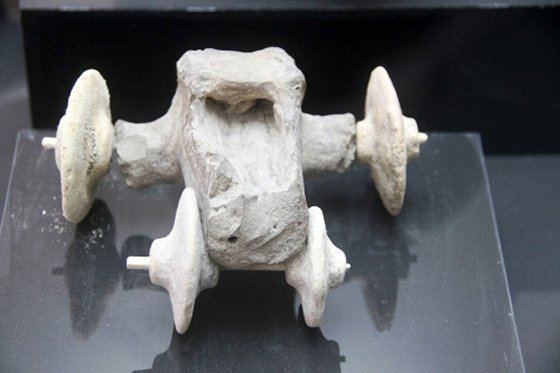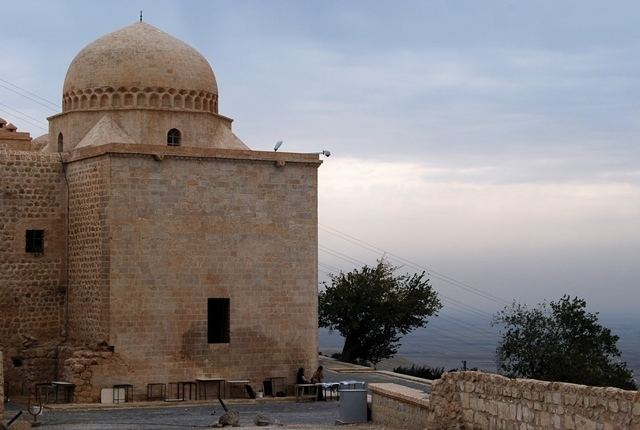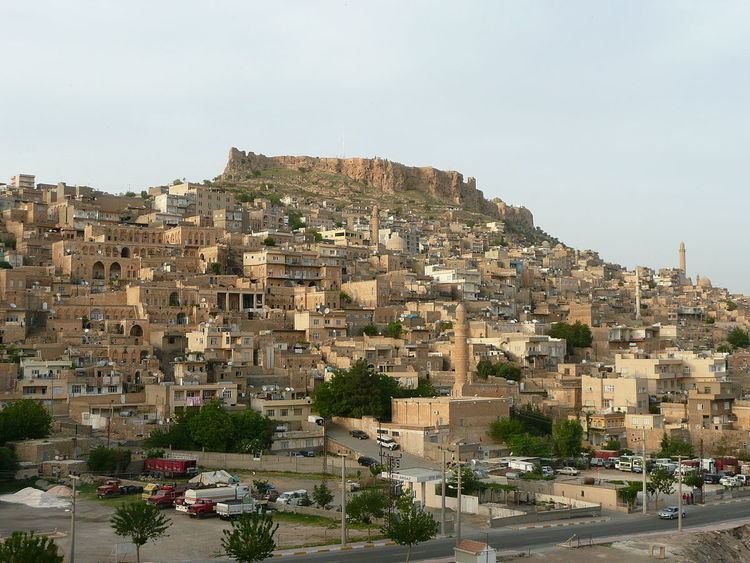Country Region Southeastern Anatolia | Elevation 1,083 m Area 969.06 km2 Mayor Ahmet Turk Februniye Akyol | |
 | ||
University Mardin Artuklu University | ||
Map of Mardin
Mardin (Kurdish: Mêrdîn, Syriac: ܡܶܪܕܺܝܢ, Arabic/Ottoman Turkish: ماردين Mārdīn) is a city and multiple (former/titular) bishopric in southeastern Turkey. The capital of Mardin Province, it is known for the Artuqid (Artıklı or Artuklu in Turkish) architecture of its old city, and for its strategic location on a rocky hill near the Tigris River that rises steeply over the flat plains.
Contents
- Map of Mardin
- The most beautiful places in mardin turkey
- The ancient city of mardin turkey
- Antiquity
- Medieval history
- Modern history
- Ecclesiastical history
- Historical landmarks
- Churches
- Mosques
- Madrassas
- Politics
- Economy
- Geology
- Climate
- Notable locals
- Twin towns Sister cities
- References

The most beautiful places in mardin turkey
The ancient city of mardin turkey
Antiquity

The territory of Mardin and Karaca Dağ was known as Izalla in the Late Bronze Age (variously: KURAzalzi, KURAzalli, KURIzalla), and originally part of a Hurrian kingdom.
The city and its surrounds were absorbed into Assyria proper during the Middle Assyrian Empire (1365-1020 BC), and then again during the Neo Assyrian Empire (911-605 BC).
The ancient name was rendered as Izalā in Old Persian, and during the Achaemenid Empire (546-332 BCE) according to the Behistun Inscription it was still regarded as an integral part of the geo-political entity of Assyria (Achaemenid Assyria, Athura).
It survived into the Assyrian Christian period as the name of Mt. Izala (Izla), on which in the early 4th century AD stood the monastery of Nisibis, housing seventy monks.
In the Roman period, the city itself was known as Marida (Merida), from a Syriac/Assyrian Neo-Aramaic language name translating to "fortress".
Between c.150 BC and 250 AD (apart from a brief Roman intervention when it became a part of Assyria (Roman province) it was part of the Neo-Assyrian kingdom of Osroene.
In the late 3rd century AD Shapur II conquered Mardin and Osroene into the Sassanid Empire (224-651 AD) after which the region became part of the province of Assuristan.
Medieval history
Byzantine Izala fell to the Seljuks in the 11th century. During the Artukid period, many of Mardin's historic buildings were constructed, including several mosques, palaces, madrassas and khans. Mardin served as the capital of one of the two Artukid branches during the 11th and 12th centuries. The lands of the Artukid dynasty fell to the Mongol invasion sometime between 1235 and 1243, but the Artukids continued to govern as vassals of the Mongol Empire. During the battle of Ain Jalut in 1260, the Artukid governor revolted against Mongol rule. Hulegu's general and Chupan's ancestor, Koke-Ilge of the Jalayir, stormed the city and Hulegu appointed the rebel's son, al-Nasir, governor of Mardin. Although, Hulegu suspected the latter's loyalty for a while, thereafter the Artukids remained loyal unlike nomadic Bedoun and Kurd tribes in the south western frontier. The Mongol Ilkhanids considered them important allies. For this loyalty they shown, Artukids were given more lands in 1298 and 1304. Mardin later passed to the Akkoyunlu, a federation of Turkic tribes that controlled territory all the way to the Caspian Sea.
During the medieval period, the town (which retained significant Assyrian and Armenian populations) became the centre for episcopal sees of Armenian Apostolic, Armenian Catholic, Assyrian, Syriac Catholic, churches, as well as a stronghold of the Syriac Orthodox Church , whose patriarchal see was headquartered in the nearby Saffron Monastery from 1034 to 1924.
Modern history
In 1517, Mardin was annexed by the Ottomans under Selim I. During this time, Mardin was administered by a governor directly appointed under the Ottoman Sultan's authority. In 1923, with the founding of the Republic of Turkey, Mardin was made the administrative capital of a province named after it.
During World War I Mardin, among many other regions of eastern Turkey, north east Syria, northern Iraq and north west Iran, was one of the sites affected by the Assyrian Genocide and Armenian Genocide, both of which ran in conjunction to the Greek Genocide. On the eve of World War I, Mardin was home to over 12,000 Assyrians and over 7,500 Armenians. In June 1915, most of the city's Christian notables and its Armenian male population were slaughtered and thrown into caves near Şeyhan. Others were sent to the infamous camps of Ras al-'Ayn, though some managed to escape to the Sinjar Mountain with help from local Chechens. Kurds and Arabs of Mardin typically refer to these events as "fırman" (government order), while Syriac Christians call it "seyfo" (sword). The Assyrians managed to strike a deal with the Turks, sparing them from most of the bloodshed. Unfortunately, the Armenians, Catholics, and Assyrians who did not manage to escape were massacred in totality, and never came back to the region. Many Assyrian survivors of the violence later on left Mardin for nearby Qamishli in the 1940s after their conscription in the Turkish military became compulsory.
After the last local election, an Assyrian Syriac Orthodox female, Februniye Akyol (Fabronia Benno), is serving as co-mayor of the town.
Ecclesiastical history
TO ELABORATEA bishopric of the Assyrian Church of the East was centred on the town when it was part of the Roman province of Assyria. It was a suffragan see of Edessa, the provincial metropolitan see.
It eventually became part of the Catholic Church in the late 17th century AD following a breakaway from the Assyrian Church, and is the (nominal) seat of three sees of the Catholic Church : the current Chaldean Catholic Eparchy of Mardin and two (now) titular sees under the ancient name of the town : former Armenian Catholic Archeparchy of Mardin, now Titular see of Mardin only, and former Syriac Catholic Eparchy of Mardin and Amida, now Titular see (initially as mere Eparchy).
Historical landmarks
Mardin has often been considered an open-air museum due to its historical architecture. Most buildings use the beige colored limestone rock which has been mined for centuries in quarries around the area. The whole city has been listed by UNESCO as a World Heritage Site under the "Mardin Cultural Landscape".
Churches
Mosques
Madrassas
Politics
In the 2014 local elections, Ahmet Türk of the Democratic Regions Party (DBP), described as "the most peaceful, most inclusive, most anti-violence, most moderate and wisest figure of the Kurdish political movement, and the one most likely to compromise," was elected mayor of Mardin. However, on 21 November 2016 he was detained "on terror charges" after being dismissed from office by Turkish authorities, and a trustee appointed as mayor.
Economy
Historically, Mardin produced sesame. Tourism is an important industry in Mardin.
Geology
During the late Permian ~250 mya the Afro-Arabian plate started opening up. The East African continental rift initiation is believed to have started around 27-31 million years ago with the beginning of the basaltic volcanism of the Afar Plume. This rift system would cause a contractional tectonic process to occur in which the Arabian Plate was pushed in a north-easterly direction towards the Eurasian plate. The divergence in the East African Rift would eventually cause the closure of the Tethys Ocean as the Arabian Plate made its first inception of collision with Eurasia between 25-23 million years ago, and complete closure around 10 mya and creation of the Mardin High.
Climate
Mardin has a hot-summer Mediterranean climate with hot, dry summers and cold, wet, and occasionally snowy winters. Temperatures in summer usually increase to 40 °C (104 °F) due to Mardin being situated right next to the border of Syria. Snowfall is quite common between the months of December and March, snowing for a week or two. Mardin has over 3000 hours of sun per year. The highest recorded temperature is 42.5 °C (108.5 °F). Average rainfall is about 641.4 mm (25 inches) per year.
Mardin-Kızıltepe, with +48.8 °C (119.84 °F) on August 14, 1993, holds the record for the highest temperature ever recorded in Turkey.
Notable locals
Twin towns — Sister cities
Mardin is twinned with:
